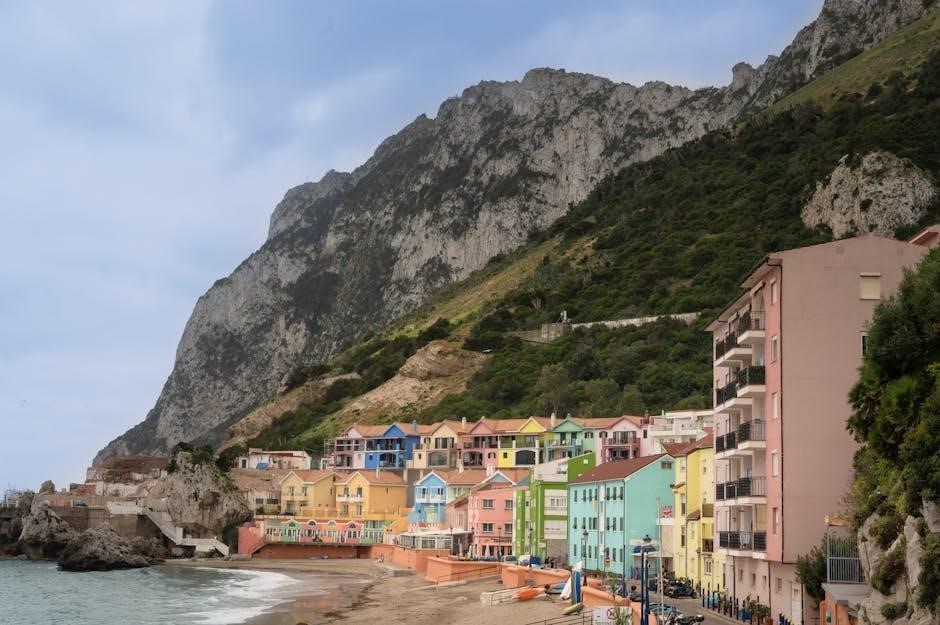Borderlands/La Frontera: Anzaldúa’s Exploration of Identity
Gloria Anzaldúa’s Borderlands/La Frontera delves into the complex identities forged within the U.S.-Mexico border. Through prose and poetry, she examines the literal and figurative borderlands, shaping Chicano identity and feminist perspectives, exploring mixed-race heritage.
Overview of Borderlands/La Frontera
Borderlands/La Frontera: The New Mestiza, published in 1987, is a seminal work by Gloria Anzaldúa, blending memoir, critical theory, and poetry. It explores the U.S.-Mexico border’s impact on communities, examining physical and metaphorical borderlands. Anzaldúa gives voice to those living within multiple identities, particularly Chicanos. The book delves into the complexities of living in a borderland, celebrating hybridity while critiquing cultural norms. It addresses themes of identity, conflict, heritage, and language, advocating for the embrace of all aspects of one’s heritage. Anzaldúa’s work challenges readers to confront societal boundaries and understand the experiences of those caught between cultures. She conceptualizes the borderlands as a space of possibility and transformation, urging the recognition of the New Mestiza consciousness.

Anzaldúa’s Life and Influences
Gloria Anzaldúa, a Chicana feminist theorist, drew from her Tejano heritage and experiences along the Rio Grande Valley. Her work was influenced by queer theory, cultural activism, and a desire to explore mixed-race identity.
Early Life and Tejano Heritage

Gloria Anzaldúa’s early life profoundly shaped her literary and theoretical contributions, particularly her exploration of identity in Borderlands/La Frontera. Rooted in the Rio Grande Valley, her family’s long history in the region provided a deep connection to Tejano culture. This heritage became a central theme in her work, informing her understanding of borders, both physical and metaphorical. Anzaldúa’s upbringing exposed her to the complexities of living between cultures, languages, and identities.
Her experiences as a Chicana lesbian feminist significantly influenced her perspective, leading her to critique both mainstream American society and traditional Chicano culture. Anzaldúa’s work gave voice to those marginalized within marginalized communities, challenging conventional notions of identity and belonging. This unique intersection of personal history and social consciousness laid the foundation for her groundbreaking exploration of the “new mestiza.”
Chicana Feminist Literature Context
Borderlands/La Frontera emerged as a foundational work within Chicana feminist literature during the 1970s and 1980s. This literary movement responded to the male-dominated Chicano Movement, seeking to address the specific experiences and concerns of Chicana women. Writers like Anzaldúa challenged traditional gender roles and explored the intersection of race, class, and sexuality.
Her work built upon earlier Chicana novels and contributed to a growing body of literature that gave voice to marginalized perspectives. Anzaldúa’s unique contribution lay in her blending of personal narrative, critical theory, and poetry. This innovative approach allowed her to explore the complexities of identity and belonging in a way that resonated deeply with readers and scholars alike. Borderlands provided a powerful lens for understanding the challenges and triumphs of Chicanas navigating multiple cultural contexts.

Key Themes and Concepts

Borderlands/La Frontera explores key themes: the borderlands as a physical and metaphorical space, Mestiza consciousness and hybrid identity, and the intersections of language and culture. Anzaldúa examines these concepts through personal narrative and cultural analysis.
The Borderlands as Physical and Metaphorical Space
In Borderlands/La Frontera, Anzaldúa presents the borderlands as both a tangible geographical location and a symbolic realm. The physical borderlands, specifically the U.S.-Mexico border, are portrayed as a site of constant crossing and cultural exchange, yet also a place of conflict and division. This “thin edge of barbwire,” as Anzaldúa describes it, becomes a metaphor for the liminal spaces inhabited by those with multiple, often conflicting, identities.
The borderlands represent a psychological and spiritual state where individuals grapple with their heritage, language, and sense of belonging. It’s a space where cultures collide, creating new hybrid forms of expression and identity. This metaphorical borderland is a place of constant negotiation and transformation, where the boundaries between self and other become blurred. Anzaldúa herself embodies this borderland existence, navigating the complexities of her Chicana, lesbian, and feminist identities.
Mestiza Consciousness and Hybrid Identity
Central to Anzaldúa’s work is the concept of “mestiza consciousness,” a state of awareness that emerges from embracing one’s mixed heritage. The mestiza, a person of mixed Indigenous and European descent, embodies the hybridity and fluidity of identity within the borderlands. This consciousness transcends fixed categories, allowing for the integration of multiple perspectives and experiences.
Anzaldúa argues that embracing mestiza consciousness is a form of resistance against the dominant culture’s pressure to conform to a single identity. It involves dismantling internal barriers and embracing the contradictions inherent in living between worlds. This hybrid identity is not simply a blending of cultures, but a creation of something new – a consciousness that is both rooted in the past and oriented towards the future. The mestiza is a “forerunner of a new race,” capable of navigating the complexities of the borderlands with resilience and creativity.
Language and Cultural Intersections

Anzaldúa intricately weaves language and culture to illustrate the multifaceted intersections within the borderlands. She employs code-switching, seamlessly blending English and Spanish, reflecting the linguistic reality of Chicanos. This technique mirrors the merging of cultural identities and serves as a powerful tool for expressing the nuances of borderland experiences.
Language, in Anzaldúa’s view, is not merely a means of communication but a repository of cultural memory and identity. By embracing multiple languages, she challenges linguistic purism and celebrates the hybridity of borderland vernacular. Her writing reflects the vibrant interplay of cultures, where traditions, beliefs, and values converge and diverge. The borderlands become a space of cultural negotiation, where individuals navigate between different worlds, creating a new synthesis of identity and expression. Anzaldúa’s work highlights the power of language to shape and transform cultural landscapes.

Analysis of “To Live in the Borderlands”
“To Live in the Borderlands” explores mixed-race identity, urging embracing heritage to navigate cultural intersections. Anzaldúa uses prose and verse to examine themes of identity, conflict, and borders, portraying a complex world.
Themes of Heritage, Conflict, and Identity
Anzaldúa’s “To Live in the Borderlands” intricately weaves together themes of heritage, conflict, and identity, presenting a powerful exploration of the liminal space inhabited by those of mixed ancestry. The poem confronts the challenges of navigating multiple cultural landscapes, where one is “neither hispana india negra espanola ni gabacha.” This line highlights the fragmented sense of belonging experienced by individuals caught between different worlds, carrying the weight of multiple heritages on their backs.
The conflict arises from the internal struggle to reconcile these disparate identities, as the “india in you, betrayed for 500 years, is no longer speaking to you.” This sense of historical trauma and cultural alienation further complicates the individual’s quest for self-understanding. Ultimately, Anzaldúa suggests that embracing this hybridity, this “mestiza consciousness,” is crucial for survival and self-affirmation in the borderlands. This embrace requires acknowledging and integrating all aspects of one’s heritage, even those that are conflicting or marginalized.
Literary Techniques: Code-Switching, Metaphor, and Repetition
Anzaldúa masterfully employs various literary techniques in “To Live in the Borderlands,” enriching the poem’s thematic depth and impact. Code-switching, the seamless blending of English and Spanish, serves not merely as a stylistic choice but as a representation of the borderland’s linguistic reality. This technique underscores the hybridity of identity and the fluidity of cultural boundaries.
Metaphors are also abundant, offering symbolic insight into the borderland experience. The “crossfire between camps” vividly illustrates the internal and external conflicts faced by individuals navigating multiple cultural allegiances. The wind stealing ones voice, personification represents the struggle to articulate one’s thoughts.
Repetition, particularly the refrain “To live in the borderlands means,” reinforces the central question of the poem: what does it mean to exist in this liminal space? The recurring phrase grounds the poem in its core thematic concerns, emphasizing the complexities and contradictions inherent in the borderland identity. Anzaldua also uses alliteration such as burra, buey.
Interpretation of Stanzas and Key Lines

The opening stanza of “To Live in the Borderlands” immediately confronts the reader with the multifaceted nature of borderland identity. The line “ni hispana india negra espanola ni gabacha, eres mestiza, mulata, half-breed” dismantles singular labels, emphasizing the hybridity inherent in the borderland experience. The stanza captures the disorientation and displacement felt by those “caught in the crossfire between camps,” struggling to reconcile conflicting aspects of their heritage.
The second stanza delves into the suppression of indigenous heritage, juxtaposing it with the juggling of identity. Key lines like “the india in you, betrayed for 500 years, is no longer speaking to you” highlight the historical trauma and cultural alienation experienced by borderland inhabitants. The third stanza uses “Cuando vives en la frontera” a reiteration to describe the obstacles one might encounter. The poem borders on a stream of consciousness style.

Critical Reception and Legacy

Borderlands/La Frontera has profoundly impacted Chicana/o Studies, feminist theory, and queer theory. Anzaldúa’s work remains relevant today, offering insights into identity, culture, and social justice and mixed-race identity urging the embrace of all heritage.
Impact on Chicana/o Studies
Borderlands/La Frontera is a foundational text in Chicana/o Studies, giving voice to those existing between multiple identities. Anzaldúa’s work challenged the male-dominated Chicano Movement by presenting a Chicana feminist perspective. She insisted on the world taking Chicano people seriously while critiquing Chicano culture from a lesbian feminist point of view.
Her exploration of the borderlands, both literal and figurative, provided a new framework for understanding the complexities of Chicana/o identity. Anzaldúa’s concept of “mestiza consciousness” has been particularly influential, offering a way to reconcile conflicting cultural influences. The book expresses the complexities of living in a borderland.
Her insights into language, culture, and identity have profoundly impacted the field, inspiring further scholarship and activism. Anzaldúa also conceptualizes the borderlands as a physical and non-physical space.
Influence on Queer Theory and Feminism
Borderlands/La Frontera significantly impacted queer theory and feminism by challenging traditional notions of identity and sexuality. Anzaldúa’s work provided a powerful voice for queer Chicana women, whose experiences were often marginalized within both the Chicano Movement and mainstream feminist discourse. She refuses to be confined to a single language.
Her exploration of “mestiza consciousness” offered a framework for understanding the fluidity and hybridity of identity, resonating with queer theorists who sought to deconstruct binary categories. Anzaldúa’s work has inspired countless scholars and activists to embrace intersectionality and challenge oppressive systems.
The book expresses the complexities of living in a borderland, both literally and figuratively. It is a foundational work of Chicana feminist literature. She also explores how the U.S.-Mexico border has shaped communities. Anzaldúa’s insights into language, culture, and identity have profoundly impacted feminism.
Contemporary Relevance of Anzaldúa’s Work
Gloria Anzaldúa’s Borderlands/La Frontera remains profoundly relevant today, offering critical insights into contemporary issues of identity, immigration, and social justice. In an increasingly globalized world, her exploration of borderlands as spaces of cultural hybridity and conflict continues to resonate with diverse communities. She examines the literal and figurative borderlands.
Her work challenges us to confront the complexities of identity formation in a world marked by constant movement and cultural exchange. Anzaldúa’s concept of “mestiza consciousness” provides a valuable framework for navigating the challenges of living in a multicultural society, urging us to embrace hybridity and resist the temptation to essentialize identity.
Furthermore, her unflinching critique of power structures and her commitment to social justice continue to inspire activists and scholars working to create a more equitable world. Anzaldúa’s work serves as a reminder of the importance of amplifying marginalized voices.
